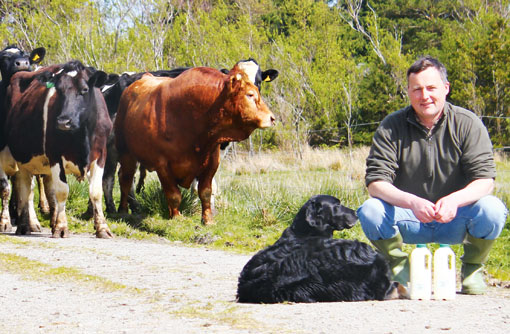Island life – it’s dairying with a difference

I was amazed and shocked to see a farmer out in his combine one sunny Sunday when I was out and about in West Sussex earlier this summer.
What’s more, I was practically laughed out of the Farmers Weekly office when I asked my colleagues if this was a rarity or if farmers actually carry on as normal on a Sunday.
It’s certainly not something that happens back home on my family’s dairy farm. The Sabbath is still strictly observed and our Massey is stored neatly away every Sunday.
Everything else carries on as normal – the cows get milked and fed, we process and bottle the milk and we deliver to the hotels and restaurants serving food on a Sunday – but so as not to offend or upset any of our customers, we have chosen not to be seen to actively farm for that one day.
Supposing we are half way through silaging during the rarity that is a Hebridean dry spell, everything grinds to a halt on a Sunday (inevitably the rain will be back on the moment we get the harvester out on the Monday).
An unusual approach to Sundays is, in fact, just one the many quirks and trivialities of dairying on a small island.
For instance, a breakdown is a nightmare for any dairy farmer, but it’s a different ball game when you are the only one on a small island. Our nearest neighbouring dairy farmer is on the mainland, so we can’t call them up and ask to quickly borrow a part.
When the pasteuriser decides to play up or a valve in the milking parlour is causing a problem, we either attempt to fix it ourselves, persuade a local engineering student to take on the challenge in return for a few drams or, if all else fails, we have to fly in a specialist engineer – much to the horror of my grandfather who manages the finances with a fine toothcomb.
Our current reliance on importing milk from the mainland is also proving to be problematic at times, with unpredictable weather regularly causing disruptions to the ferry service, leaving us short at a time when our customers are bulk-buying in a typical no-ferry-makes-islanders-panic way.
It would perhaps make more sense to go for a higher yield from our cows – or “granny cows” as I call them due to them having an average lactation of 6-7. My father, however, is a firm believer in the old adage “it’s the old cows that pay the bills”.
Ferry travel and arranging a livestock haulier also determines when and how we take store cattle away to market, or bring in replacements, as we don’t have the space to breed our own.
I’ll never forget my mother’s horror that my brother didn’t have enough vests – he was seven at the time – while on a trip to buy cows with my grandfather.
Upon arrival at Ullapool on a Saturday to catch the ferry back to Stornoway, they were sent away because there were too many refrigerated lorries to allow livestock in the hold. As this happened long before the introduction of Sunday sailings – an event which caused a lot of controversy in Stornoway with several “silent protests” – my brother and grandfather returned to the farm they’d got the cows from until they could get back to the island on the Monday.
While the hot topic of wildlife-related problems is badgers and bovine TB, the crofters and farmers in the Western Isles are constantly battling the persistent problem of Greylag geese who have decided to take up residence on the islands. No amount of licensed shooting seems to keep them under control.
In fact, the situation is so extreme these days, a man has been employed at the airport to prevent any birdstrikes. At least the sport of geese deterring has given our dairyman a new hobby; he recently built a lady scarecrow complete with a tartan skirt, hair extensions and lacy tights. Whether that will scare the geese away remains to be seen.
Goathill Farm Dairy
• Most westerly dairy farm in Scotland and only one in the Western Isles. There are few farms on the islands, and most of the land is farmed by crofters. |
|---|
Isle of LewisThe Isle of Lewis has a population of just over 18,000 and is the largest island in the Western Isles or Outer Hebrides as they are sometimes known. It is a two-hour 45min journey by boat to Ullapool on the mainland. This means any trips to the auction mart in Dingwall involve at least four hours travelling with the stock. Famous island exports include Harris Tweed, Stornoway black pudding and Scottish salmon. The main industries are: tourism, fish farming and tweed production. |
|---|
• What quirks of geography do you have to deal with on your farm? What family traditions do you continue to observe, whether they make sense or not? In short, what makes farming on your farm unique? Join the dicussion on our website forums.
